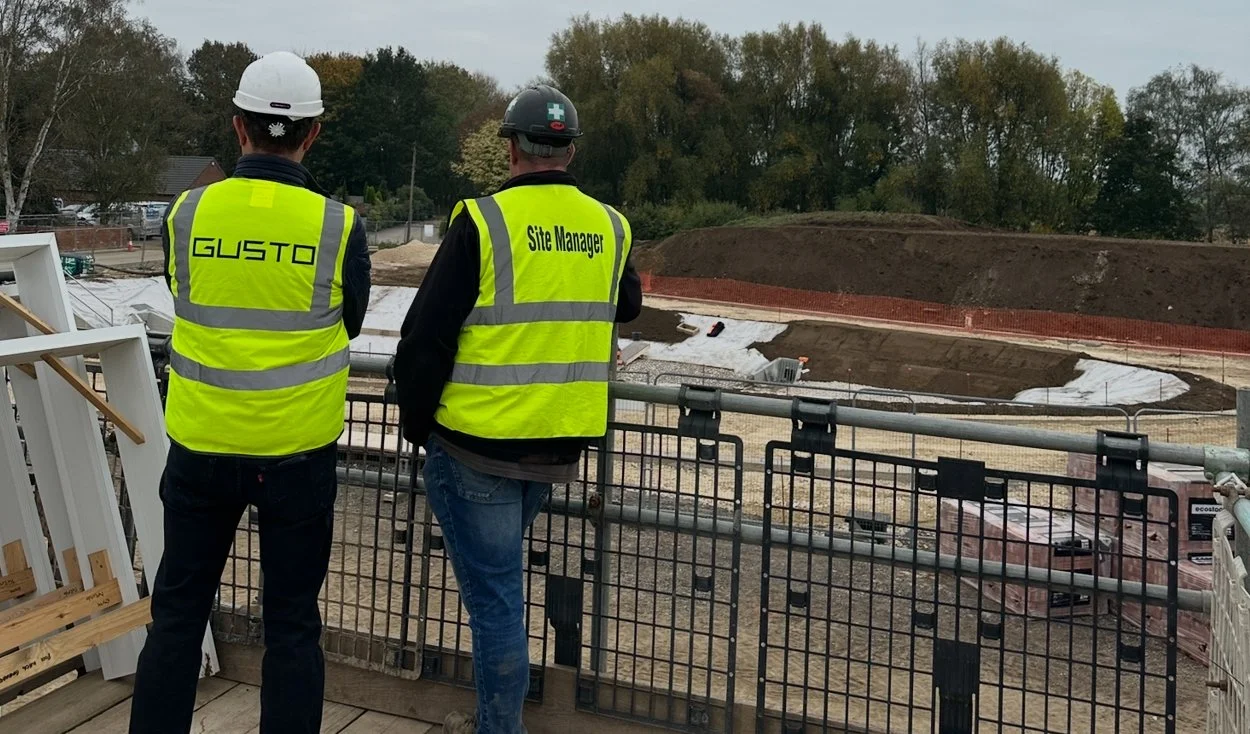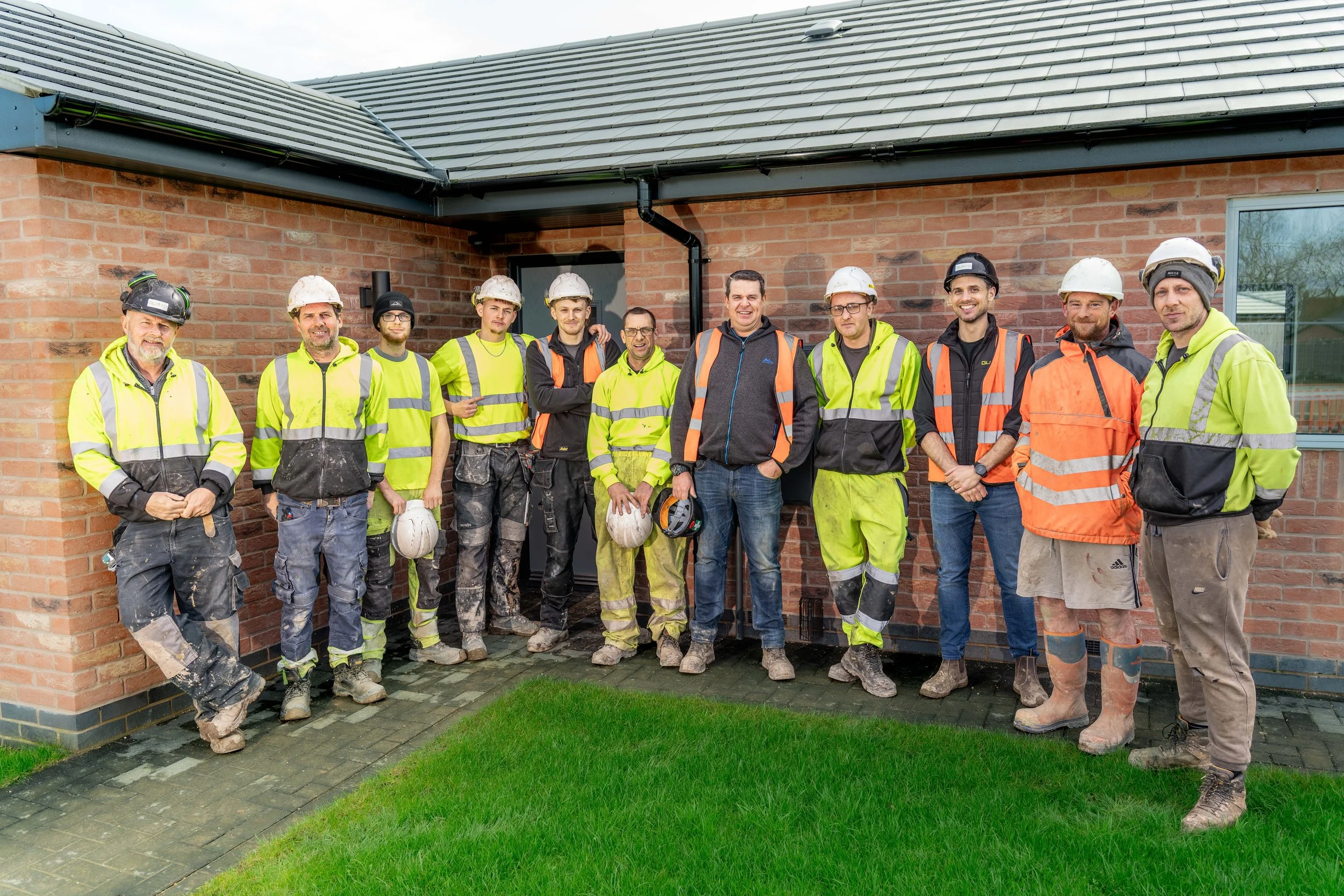Steff Wright: “Let’s hold ourselves to higher building standards until legislation catches up.”
By Steff Wright, Chairman at Gusto Construction
At Gusto Construction we’ve been pioneering above-regulation building standards since the late 1990s and setting our own sustainability criteria. With heating and powering buildings accounting for 30% of the UK’s total energy usage, regulations such as the Future Homes Standard shouldn’t be seen as a target to reach and stop at. We know our industry can do better and we should be setting our own benchmarks rather than settling for the bare minimum.
I’ve long argued that there needs to be incentives at a government level for developers to go over minimum building standards, but this isn’t an excuse. In the absence of legislation, we should be holding ourselves and each other to the highest standard we can, not waiting for it to be mandated.
Steff with Site Manager, Darren.
Legislation should be incentivising us to build to higher standards
At Gusto Construction we’ve been successfully building sustainable communities for over two decades. Our first development, Millennium Green in 1998, resulted in 24 new homes which, in broad terms, used 50% less energy and 50% less water compared to houses built to contemporary building regulations at the time.
So we’ve shown that sustainable communities are achievable, but when it comes to using natural materials, for example, we also know that businesses are often held back by the continual balancing act of profitability.
Currently, it is significantly cheaper to use materials to build houses that have a high level of embodied carbon in them, such as concrete, bricks, blocks, plastic, fiberglass or polyurethane insulation, rather than natural materials. This is simply because natural materials haven't been sufficiently scaled as a viable alternative.
We require processes like carbon taxes to make fossil fuel derived materials more expensive to buy, and simultaneously there needs to be incentives to grow the market around natural building materials in order to create more cost-effective natural options.
It all boils down to making the solution work commercially and reaching a turning point where the sustainable choice also becomes the most logical and cost-effective one. In this scenario, it would be the moment at which builders choose to use natural materials because it makes financial sense to do so.
Developers are currently held to the low standards of basic building regulations and there are minimal incentives to go beyond these. Labour has pledged to ‘get Britain building again’ but with minimal drivers from the government for companies to do any more than pay lip-service to sustainable commitments, there is little reason for developers to do so.
The Gusto Construction Team
Currently, there are only a few small housing builders who are taking the lead on technologies that can push us towards zero carbon targets by building to a higher standard.
Practices such as a tax on carbon intensive materials, would prompt builders to be more conscious of the materials they’re using and their processes. Initiatives like the AECB (Association for Environment Conscious Building) for example, are attracting members and driving sustainable practices across the sector.
But we should also want to build in a way that benefits the communities around us
Customers have fed back on the physical advantages of living in one of our houses via post-occupancy evaluation by the University of Lincoln, but also highlighted the strong community created.
A homeowner at Woodlands Edge commented: “Living in a Gusto home is the best leap into the future. I strongly believe that now this exceptional standard has been set, building regs should require all new builds to be this good. I don’t know of anyone else whose homes measure up.”
To me, this is what developers need to aspire to; moving past monetary gains as the sole driver of building houses. Whilst using cheaper materials is the most financially lucrative option, the current model doesn’t generate any drive for innovation. We need to look at value in different terms; designing houses that are appealing to live in, with the wider community and planet in mind.
What standards does Gusto Construction build to?
We are now due to build our 250th low energy home and have also made a commitment that over 50% of all our future homes will meet our low energy and low impact specifications.
This means that we have now built more low energy homes than those constructed to standard building regulations with 210 of our 400 homes meeting our high-performance low energy criteria and 47 more currently in construction. Many of these include advanced features such as solar panels, triple-glazed windows, heat recovery from wastewater, 150mm wall cavities for insulation and all-electric systems powered by air source heat pumps and infrared heating.
Woodlands Edge
We’ve also just released our latest development of 39 new homes at Easthorpe, all of which are being built to the AECB standard (equivalent to Gusto Construction’s low energy criteria) created by the Association of Environmentally Conscience Builders to ensure that the homes require a minimal amount of energy to run and maximise their ability to generate solar electricity. Our Easthorpe show home is now open, giving the public the opportunity to see first-hand the benefits of living in a low energy home
Whilst we’re proud to have built more low energy homes than standard ones, we also know we can go further. This isn’t about achieving perfection, instead we want to strive for constant progression and driving one another to do better. This is why we have homes in our pipeline being built with natural hemp-based building fabrics.
We’ve shown that building sustainable communities is achievable but there are financial roadblocks for many. We need to reach a point where the sustainable choice also becomes the most logical and cost-effective one.



